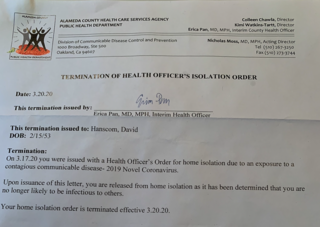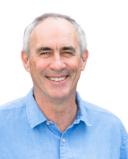Coronavirus Disease 2019
Solve the Pandemic Now—Create the “Herd”
I am “free” by testing positive for COVID-19.
Posted March 24, 2020 Reviewed by Ekua Hagan
“Unless you are seriously ill, you don’t need to be tested for the coronavirus.” These were the first words I heard today from the Presidential leadership team as I walked in the front door this afternoon. For several reasons, this is the worst possible advice.
There are two aspects of dealing with the current COVID-19 pandemic. One is minimizing the impact of the disease and the other is returning people safely back into circulation as soon as possible. We have understandably focused on preventing the spread, but it is time to also turn our attention to the social implications. People need to be freed up to live—now. This can only be achieved safely by widespread testing for the virus or antibodies.
"Herd immunity"
Epidemics/ pandemics are stopped when there is sufficient immunity in the population to prevent further spread. With stable viruses, such as polio, measles, smallpox, hepatitis B, and others, this level of immunity can be induced with vaccines. With unstable viruses that mutate, such as influenzas and the Coronavirus, this is achievable when enough people become infected and a “herd” immunity develops.
We have concentrated on preventing the spread of the virus because we know that we can’t contain it and we are not prepared for its consequences. The majority of the population will be exposed to it. We can “flatten the curve” and we don’t need to sacrifice the lives of hundreds of thousands of patients. But we can greatly speed up getting back to work and into life by accurately defining and increasing the size of the “herd.”
I tested positive for COVID-19 and I am now free
I became acutely ill about two weeks ago with a low-grade fever, diffuse muscle aches, and fatigue. I had been on airplane trips but not to areas that would be considered high risk for exposure. I was also not in a crowd or close to symptomatic people. My primary care provider somehow allowed me to be tested in San Francisco the next day. It took six days to receive the results while I stayed isolated in my house.

Much to my surprise, the test came back positive. If I didn't have an insistent wife, I would not have been tested. Everyone was supportive and concerned, and I was bummed out–until I figured out that I had just gotten my “Get out of jail free” card.
I had experienced fatigue and muscle aches for four days. The fever never returned, and I have been feeling fine for over a week. I met the Alameda County/CDC criteria for being in the “recovered” group. I am part of the “herd” that is no longer contagious and I have immunity at least for this phase of the coronavirus epidemic.
I am free and can re-enter life. That would not have been possible without the test. After the onset of symptoms, I could have remained inside for two weeks and then taken an empiric guess that I was part of the “herd.” But now I know and can relax.

Chronic stress—fear of the unknown
I am a 67-year-old orthopedic spine surgeon, who quit my practice about a year ago to concentrate on bringing solutions for chronic pain into the public domain. In the process, I have been able to interact with many brilliant minds regarding the neurochemical nature of chronic pain. Part of my journey has given me the privilege of working with Dr. Steven Porges, who proposed “The Polyvagal Theory.” (1) He provides a clear delineation between the different roles of the autonomic nervous system and the effects on various organ systems of the body. This also includes the neuroendocrine axis and immune systems.
One critical aspect is the stimulation of the immune system, which fights off outside microbes and viruses every second. Acute stress fires it up and is protective, but chronic stress compromises your body’s neurochemical defenses against invaders. One way of creating chronic stress is not allowing people to know if they are ill or not, and then treating high and low–risk patients in the same manner. The ongoing messaging hearing from the news cycle is that you might die or cause someone else to be infected. This is not reassuring at any level. Aggressive testing of the entire population would help allay these fears and collectively improve immune function.
"Recovered"
Safely increasing the size of the “herd” has many facets to it, but I am making only one set of suggestions to hopefully catalyze productive conversations around this aspect of solving the pandemic.
- Parameters to enter the “recovered” group need to be defined and made public.
- The one definite group would be those who did test positive, and then had a defined period of time without symptoms. This is still up for debate, but the current criteria is no symptoms (specifically fever) for three days.
- This is a virus that mutates, so we don’t know the depth and length of the immunity. I am not assuming that I will be immune next “season”, but I have to assume I have a reasonable immunity at the moment. Otherwise, there would never be an end to any epidemic.
- Antibody testing to document if you ever had it at would be more effective, but the technology is not widely available.
There are other definitions of “recovered” that can be discussed and are beyond my level of expertise. This set of suggestions is just the most concrete.
Social isolation and the autonomic nervous system
This virus will be in the population for a while, and social measures will be harder and harder to enforce over time with increasing societal disarray. Dr. Porges succinctly pointed out that humans evolved through social interaction with the vagus nerve being in the center of it all. Social isolation is going to cause dysregulation of the autonomic nervous system, with the potential for a lot of negative consequences.
This is what needs to be done now in addition to what we are doing.
- Test, test, test – everyone with or without symptoms. We have to define this problem to solve it. The cost would be a small fraction of what is happening to the economy.
- If the test is negative while you have symptoms, aggressive re-testing is warranted.
- If you are positive for the virus, the CDC has guidelines that will tell you when you are in the “recovered” group. That means you are now part of the "herd" group and can re-enter normal life. The criteria for defining “recovered” needs to be made widely known. There is still a lot of controversy, which is unnecessary since we already know a lot from the experience of other countries.
- The news needs to focus on the “recovered” group and not on the endless fear-mongering. This ongoing disturbing input is also compromising your immune system.
Optimize your own immune system
Other actions must be encouraged to optimize your own immune system. Here are some suggestions.
- Adequate sleep has a marked effect on strengthening immunity.
- Processing anger and anxiety requires a much different approach than you might think. It is a learned skill.
- Expressive writing has been shown to decrease viral load and improve immune function.
- Mindfulness and meditation are known to diminish your stress hormones.
- Don’t discuss your pain with anyone. No complaining, gossiping, giving unasked-for advice, or criticism. All of these activities elevate, not lower your stress hormones.
- Limit your watching of the news to 30 minutes or less per day and never at bedtime.
- Play–connecting with family and friends has a profound healing effect through optimizing your body's chemistry to oxytocin (love drug), growth hormone, dopamine (rewards), GABA (anti-anxiety), and serotonin. One possibility is having virtual gatherings of friends and family. We have attended several "cocktail parties" and hosted a "family brunch" over the Internet.
It is critical for all of us to safely create this herd immunity quickly, and more importantly, get people back into circulation to participate in society. The fallout from the social disruption promises to be possibly more severe than that of the virus. This virus will be with us for a while but with clear thinking and action, we can minimize the societal disruption without undue risk.

This is an image to put in your mind not only for dealing with this pandemic but also creating a model for your life. Recovery is possible when proper actions are taken. You are in charge of your own destiny.
References
1. Porges, Stephen, The Polyvagal Theory. Norton and Co. New York, NY, 2011.




